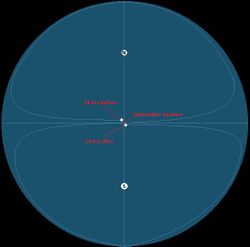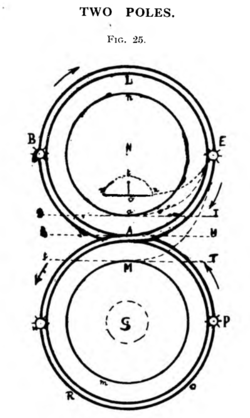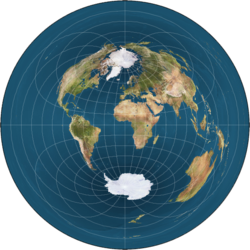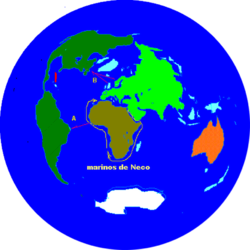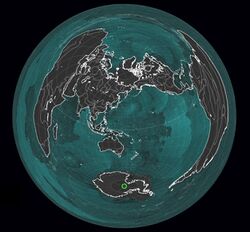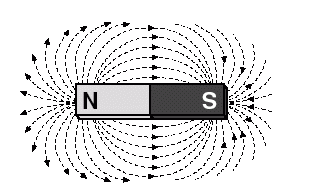Difference between revisions of "Bi-Polar Model"
Tom Bishop (talk | contribs) (→Maps) |
PeteSvarrior (talk | contribs) m (Reverted edits by 107.167.244.83 (talk) to last revision by Tom Bishop) Tag: Rollback |
||
| (191 intermediate revisions by 2 users not shown) | |||
| Line 1: | Line 1: | ||
| − | The '''Bi-Polar Model''' is a model of the earth which was | + | The '''Bi-Polar Model''' is a model of the earth which was devised by the Universal Zetetic Society, the precursor to the Flat Earth Society, in the early 1900's following claims of further exploration of Antarctica and discovery of the South Pole. This model features two poles and an Antarctic continent which exists in standard contexts. An 'Ice Wall' still exists in this model, but it is not Antarctica. It is assumed that beyond the rays of the sun the waters will naturally freeze. |
| + | |||
| + | The existence of a South Pole has been long theorized. Prior to Samuel Rowbotham's ''Earth Not a Globe'' in the mid-1800's, the Flat Earth model had multiple poles (See: ''[[The Anti-Newtonian]]''). It is thought that Rowbotham simplified the matter to one pole in his work due to the lack of direct evidence at the time for additional poles. The Bi-Polar Model reverts to the original concepts of multiple poles. | ||
| + | |||
| + | ==Explanatory Video== | ||
| + | |||
| + | Flat Earth Crush has produced content on the Bi-Polar model which showcases some of its benefits. It should be noted that the author has mentioned in other videos on the topic that he using the selected map as a placeholder only for his purposes. Runtime: 15m | ||
| + | |||
| + | {{#ev:vimeo|https://vimeo.com/399727902}} | ||
| + | |||
| + | A mention of the Southern Celestial Rotation in the Monopole model is made. The Southern Celestial Rotation under the Monopole model is [https://wiki.tfes.org/Southern_Celestial_Rotation discussed here]. | ||
| + | |||
| + | Related videos by Flat Earth Crush: | ||
| + | |||
| + | :*[https://vimeo.com/399749202 New Flat Earth Model Trumps Globe] | ||
| + | :*[https://vimeo.com/399749135 Flat Earth Breakthrough] | ||
==Maps== | ==Maps== | ||
| − | There are a wide variety of continental layout possibilities for Bi-Polar map. The continental layout is unknown and has | + | There are a wide variety of continental layout possibilities for a Bi-Polar map. The continental layout is unknown and has yet to be fully researched due to ambiguities of jet streams, flight routing, and non-direct flights (See: [[Issues in Flight Analysis]]). The Bi-Polar model is sometimes illustrated with vertical ovals, vertical circles, or with a placeholder map. |
| − | [[File:BiPolar-Shafto.jpg| | + | [[File:BiPolar-Shafto.jpg|250px]] [[File:Bi-Polar-Sea-Earth.png|250px]] [[File:Altmap.png|250px]] [[File:Sandokhan_map.png|250px]] [[File:Atlantic Split Bi-Polar.jpg|250px]] |
:<sup>1. From Bobby Shafto<br> | :<sup>1. From Bobby Shafto<br> | ||
| − | :<sup>2. | + | :<sup>2. From [http://library.tfes.org/library/Sea-Earth%20Globe.pdf ''The Sea-Earth Globe and and its Monstrous Hypothetical Motions (1918)''] by Zetetes (p.30)<br> |
| − | :<sup>3. Origin Unknown | + | :<sup>3. Origin Unknown - centered on Prime Meridian |
| + | :<sup>4. Sandokan's map | ||
| + | :<sup>5. A Pacific Ocean-centered variant | ||
| + | |||
| + | ==Circumnavigation== | ||
| − | + | The needle on a compass aligns with the magnetic field lines. Circumnavigation involves traveling Eastwards or Westwards in relation to those field lines, taking you around the nearest pole. On a Bi-Polar model the magnetic field lines would spread out from the North and South poles like the magnetic field lines on a bar magnet. | |
| − | + | [[File:Bar-Magnet-Field-Lines.gif|400px]] | |
| − | == | + | The needle of a compass would align with those magnetic field lines in the navigator's local area. Since East and West are at right angles to the field lines, moving East or West in relation to those field lines would take one in a circle around the North or South poles. This also implies that if one were to follow the magnetic field lines North or South that they would eventually get to the Northern or Southern poles. |
| + | |||
| + | It should be noted that the magnetic field lines which are produced by a magnet always wrap around and connect to the opposite pole, and that none travel unconnected forever into space. | ||
| + | |||
| + | ==Eastward Sunrise== | ||
| − | + | '''Q.''' How the Sun can rise from near the east under this configuration during Equinox?<br> | |
| + | '''A.''' An answer to this query may be that it is similar to [https://wiki.tfes.org/Equinox#A_Flat_Earth_Equinox its operation in the standard Monopole model]. When we observe the Sun, we are observing its [[Magnification of the Sun at Sunset|projection upon the atmolayer]]. The Sun which is seen is ''local'' to the observer. Accordingly, the easterly Sunrise is a consequence of the following: | ||
| − | + | :*The points along the edges of the Sun's circular area of light are Sunrise (or Sunset). | |
| + | :*Our vision is very limited. One cannot see infinitely into the distance. | ||
| + | :*The edge of the Sun's circular area of light is approaching the observer from the East as it intersects the observer's location. | ||
| − | The | + | Sunrise will occur from an Eastward direction as a natural consequence of the observer's limited range of vision. The Sun's circular area of light generally intersects the observer's area of vision from an Eastward direction. During Equinox the Sun's circular area of light begins by pivoting around either the Northern or Southern poles, and makes a figure eight around the model. The points along the edge of the Sun's area of light are close to traveling along the observer's latitude line as it intersects the observer's viewing area, even if the Sun is not, and will intersect and appear from near the East in initial bearing. |
| − | + | On the day of Equinox the area of sunlight is making a figure eight path and it is apparent how it may be possible for each point to see an Eastwards Sunrise as the day progresses. | |
| − | + | As an analogy, consider the following: | |
| − | + | :If a cloud was traveling along the circle of your latitude line, and you only see it when it is close to you, would you see it appear from the east or near the east? | |
| − | + | The same explanation for this occurrence is given for the local Sun and the manifestation of its initial Eastward bearing. The points along the edge of Sun's area of light are ''projections'' of the Sun upon the atmolayer, which will appear to the observer once in his or her viewing range. | |
| − | + | The Monopole Model's explanation for eastward sunrise is conceptually similar, and provides diagrams of interest. See '''[[Equinox#A Flat Earth Equinox|Equinox (Monopole)]]''' | |
| − | + | ==Sunlight Area== | |
| − | |||
| − | + | '''Q.''' Take a look at this analysis I performed from online Round Earth models of sunlight area showing perpetual light or darkness around the edges for a Bi-Polar model.<br> | |
| + | '''A.''' We recommend that the data in any such analysis comes from real world observations, rather than from a model. Much of the area which is getting stretched out on the globe model is ocean. Does the data come from people in the middle of the ocean reporting observations? If not, and if the source of this data cannot be determined, then such an analysis showing perpetual light or darkness around the edges is likely of little value in these discussions. | ||
| − | + | '''Q.''' But most people accept these models...<br> | |
| + | '''A.''' This assertion is countered by the fact that most people did not verify that those sunlight patterns are correct for every point on the Earth at all times of the year, especially in the oceans. We can only encourage the use of real data-points from real observations for any assessments of the subject-matter. | ||
| − | + | ==New York Journal== | |
| − | == | + | Of note, disagreement in the Flat Earth movement on the nature of the model appears to have always persisted. Not every FE proponent signed on to Samuel Rowbotham's Monopole model after its introduction. In 1897 the ''New York Journal'' [https://www.loc.gov/resource/sn84024350/1897-01-31/ed-1/?sp=22&r=0.424,-0.085,0.51,0.232,0 published an illustration of the Flat Earth Monopole model] ([https://web.archive.org/web/20200525221551/https://tile.loc.gov/storage-services/service/sgp/sgpbatches/batch_dlc_delancey_ver02/data/sn84024350/print2439/1897013101/0576.pdf Archive]), with the following comment, telling that there was disagreement in the Flat Earth circles around this time: |
| − | + | {{cite|In a picture of the earth as these unique theorists believe it to be—or some of them, for they do not all agree the “South Pole" is seen as a wall of ice surrounding the circular earth. This conception [of Rowbotham's Monopole model] certainly fits well with the idea of the vastness of the Southern wastes of ice which have turned back all explorers.}} | |
| − | ' | ||
| − | + | Navigation in the South has been a [[Sea Travel in the South|historically difficult endeavor]], perhaps supporting adoption of a Flat Earth Monopole model in the early Flat Earth societies. | |
| − | + | [[Category:Form and Magnitude]] | |
| + | [[Category:Maps and Models]] | ||
Latest revision as of 17:23, 15 October 2022
The Bi-Polar Model is a model of the earth which was devised by the Universal Zetetic Society, the precursor to the Flat Earth Society, in the early 1900's following claims of further exploration of Antarctica and discovery of the South Pole. This model features two poles and an Antarctic continent which exists in standard contexts. An 'Ice Wall' still exists in this model, but it is not Antarctica. It is assumed that beyond the rays of the sun the waters will naturally freeze.
The existence of a South Pole has been long theorized. Prior to Samuel Rowbotham's Earth Not a Globe in the mid-1800's, the Flat Earth model had multiple poles (See: The Anti-Newtonian). It is thought that Rowbotham simplified the matter to one pole in his work due to the lack of direct evidence at the time for additional poles. The Bi-Polar Model reverts to the original concepts of multiple poles.
Explanatory Video
Flat Earth Crush has produced content on the Bi-Polar model which showcases some of its benefits. It should be noted that the author has mentioned in other videos on the topic that he using the selected map as a placeholder only for his purposes. Runtime: 15m
A mention of the Southern Celestial Rotation in the Monopole model is made. The Southern Celestial Rotation under the Monopole model is discussed here.
Related videos by Flat Earth Crush:
Maps
There are a wide variety of continental layout possibilities for a Bi-Polar map. The continental layout is unknown and has yet to be fully researched due to ambiguities of jet streams, flight routing, and non-direct flights (See: Issues in Flight Analysis). The Bi-Polar model is sometimes illustrated with vertical ovals, vertical circles, or with a placeholder map.
- 1. From Bobby Shafto
- 2. From The Sea-Earth Globe and and its Monstrous Hypothetical Motions (1918) by Zetetes (p.30)
- 3. Origin Unknown - centered on Prime Meridian
- 4. Sandokan's map
- 5. A Pacific Ocean-centered variant
The needle on a compass aligns with the magnetic field lines. Circumnavigation involves traveling Eastwards or Westwards in relation to those field lines, taking you around the nearest pole. On a Bi-Polar model the magnetic field lines would spread out from the North and South poles like the magnetic field lines on a bar magnet.
The needle of a compass would align with those magnetic field lines in the navigator's local area. Since East and West are at right angles to the field lines, moving East or West in relation to those field lines would take one in a circle around the North or South poles. This also implies that if one were to follow the magnetic field lines North or South that they would eventually get to the Northern or Southern poles.
It should be noted that the magnetic field lines which are produced by a magnet always wrap around and connect to the opposite pole, and that none travel unconnected forever into space.
Eastward Sunrise
Q. How the Sun can rise from near the east under this configuration during Equinox?
A. An answer to this query may be that it is similar to its operation in the standard Monopole model. When we observe the Sun, we are observing its projection upon the atmolayer. The Sun which is seen is local to the observer. Accordingly, the easterly Sunrise is a consequence of the following:
- The points along the edges of the Sun's circular area of light are Sunrise (or Sunset).
- Our vision is very limited. One cannot see infinitely into the distance.
- The edge of the Sun's circular area of light is approaching the observer from the East as it intersects the observer's location.
Sunrise will occur from an Eastward direction as a natural consequence of the observer's limited range of vision. The Sun's circular area of light generally intersects the observer's area of vision from an Eastward direction. During Equinox the Sun's circular area of light begins by pivoting around either the Northern or Southern poles, and makes a figure eight around the model. The points along the edge of the Sun's area of light are close to traveling along the observer's latitude line as it intersects the observer's viewing area, even if the Sun is not, and will intersect and appear from near the East in initial bearing.
On the day of Equinox the area of sunlight is making a figure eight path and it is apparent how it may be possible for each point to see an Eastwards Sunrise as the day progresses.
As an analogy, consider the following:
- If a cloud was traveling along the circle of your latitude line, and you only see it when it is close to you, would you see it appear from the east or near the east?
The same explanation for this occurrence is given for the local Sun and the manifestation of its initial Eastward bearing. The points along the edge of Sun's area of light are projections of the Sun upon the atmolayer, which will appear to the observer once in his or her viewing range.
The Monopole Model's explanation for eastward sunrise is conceptually similar, and provides diagrams of interest. See Equinox (Monopole)
Sunlight Area
Q. Take a look at this analysis I performed from online Round Earth models of sunlight area showing perpetual light or darkness around the edges for a Bi-Polar model.
A. We recommend that the data in any such analysis comes from real world observations, rather than from a model. Much of the area which is getting stretched out on the globe model is ocean. Does the data come from people in the middle of the ocean reporting observations? If not, and if the source of this data cannot be determined, then such an analysis showing perpetual light or darkness around the edges is likely of little value in these discussions.
Q. But most people accept these models...
A. This assertion is countered by the fact that most people did not verify that those sunlight patterns are correct for every point on the Earth at all times of the year, especially in the oceans. We can only encourage the use of real data-points from real observations for any assessments of the subject-matter.
New York Journal
Of note, disagreement in the Flat Earth movement on the nature of the model appears to have always persisted. Not every FE proponent signed on to Samuel Rowbotham's Monopole model after its introduction. In 1897 the New York Journal published an illustration of the Flat Earth Monopole model (Archive), with the following comment, telling that there was disagreement in the Flat Earth circles around this time:
“ In a picture of the earth as these unique theorists believe it to be—or some of them, for they do not all agree the “South Pole" is seen as a wall of ice surrounding the circular earth. This conception [of Rowbotham's Monopole model] certainly fits well with the idea of the vastness of the Southern wastes of ice which have turned back all explorers. ”
Navigation in the South has been a historically difficult endeavor, perhaps supporting adoption of a Flat Earth Monopole model in the early Flat Earth societies.

